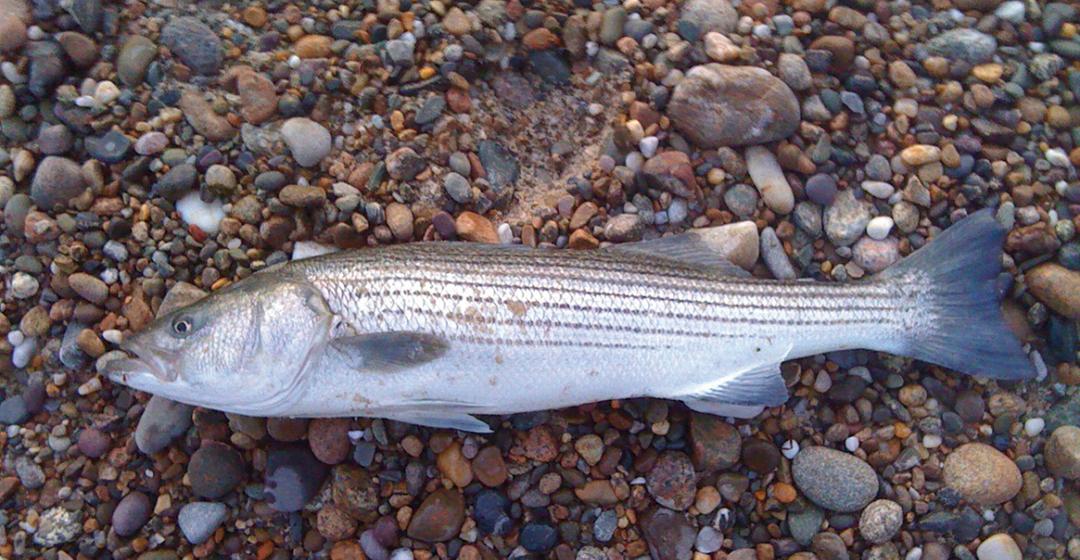There was a time when I subscribed to a theory that placed bait fishermen – meat fishermen – on the bottom rung of the evolutionary ladder. Flyrod anglers were at the top. Those who solely practiced catch-and-release were the enlightened seeking nirvana.
I got older. My shoulders began to ache under the strain of repetitive false casts with my flyrod. My outlook changed. I embraced the beach chair and sand spike. I still fly-fish, but I am just as happy to sit back, cast out a bait rig, and occasionally bring home a fresh striped bass for dinner – even if catch-and-release purists think I risk reincarnation as a squid.
It is easy to be judgmental. Recreational fishermen often point the finger at commercial fishermen for a decline in striped bass stocks. The fact is that irrespective of one’s intentions and choice of tackle, not every fish released back into the water survives. A recent report by the state Division of Marine Fisheries (DMF) puts catch-and-release striped bass mortality at about 9 percent. If that release mortality rate is applied to the almost thirteen million striped bass Massachusetts recreational anglers are estimated to have released in 2017, DMF said, “over one million striped bass died after being released. That’s compared to only 300,000 that were taken home and eaten.”
A bass played to the point of exhaustion on a flyrod and not helped to revive may not fare well. A fish hooked in the gills, esophagus, or stomach – a risk when using bait – faces more daunting odds and accounts for most of the release mortality.
Recent stock assessments that show an increase in fishing mortality, coupled with pressure from fishermen over the health of the striper fishery, has prompted state action. In February, DMF held public hearings on a proposal to mandate the use of circle hooks beginning in 2020 for anglers using certain natural baits. A decision is pending.
Unlike the conventional J-hook, where the point is parallel to the hook shaft, the point of a circle hook is not exposed, but bent inward at a ninety degree angle to the shank. On first glance, it is easy to question how it could be effective.
When a striper eats a baited J-hook, the fisherman “sets the hook” with a tug. Depending on the location of the hook, the barbed point might penetrate the jaw, throat, gills, or stomach.
When a bass takes a baited circle hook and begins to move away, the fisherman must reel until the line comes taut. The circle design allows the hook to pass up the throat and pivot in the corner of the mouth and hook the fish in the jaw. (Hooks with a circular shape but offset point are just as harmful as J-hooks.)
A study in Maryland found a 90 percent reduction in mortality when bait fishermen used non-offset circle hooks. “Imagine if we could reduce the number of release deaths from over a million fish to 100,000,” DMF said.
To properly fish a circle hook, the angler must resist the urge to set the hook, which would pull it right out of the fish’s mouth. On occasion, a fish will be hooked deep in the gullet, in which case it is best to just cut the line rather than try to remove the hook. It’s also important not to bury the point in the bait. For example, hook a whole squid once in the tail.
The main consideration when choosing a circle hook is size. For example, DMF recommends a hook size between 6/0 and 8/0 for striped bass. Educational material on circle hooks is available from DMF.
Mandated or not, it would be wrong to conclude that reducing striped bass mortality is the only reason to make the switch. Repeated studies have demonstrated that when used properly a circle hook holds fish more securely than a standard J-hook.
Commercial longline Pacific fishermen have known about the holding power of circle hooks for years. If there is anything positive to say about a fishery that utilizes thousands of baited hooks set on a line that extends for miles and kills fish indiscriminately, it is that the use of circle hooks reduces sea turtle mortality and allows non-targeted fish species to be released alive.
The circle hook is not a new idea. The oldest circle hooks were discovered on the island of Okinawa made from shell and are about 23,000 years old. Pre-Columbian Indians in Latin America, the Maori, and Pacific coast Native Americans each used hooks that looked and fished similarly to modern circle hooks.
In a 2003 report on circle hooks, the Atlantic States Marine Fisheries Commission, which is responsible for striped bass regulations along the eastern seaboard, noted that an estimated 1.3 million striped bass were lost due to recreational hook and line release mortality in 2000 – “more than the number landed by the commercial fishery that year.”
The report called for more education, angler outreach, and promotions designed to increase the use of circle hooks. That was sixteen years ago. Better late than never, I suppose. Circle hooks work.





